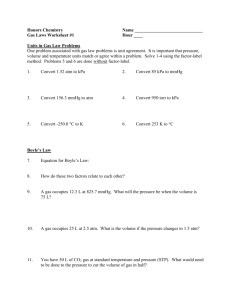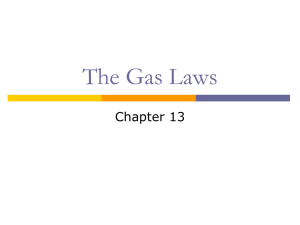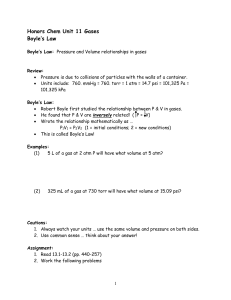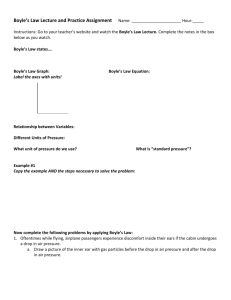Slide 1 - Brookwood High School
advertisement
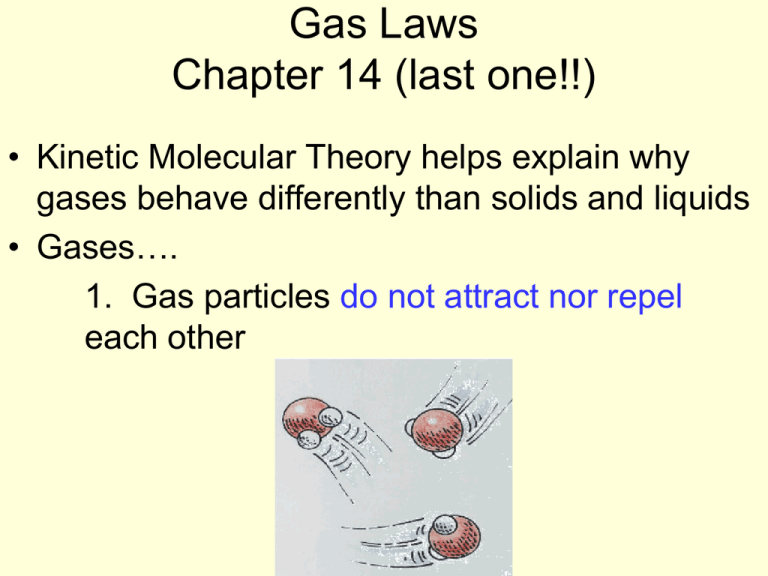
Gas Laws Chapter 14 (last one!!) • Kinetic Molecular Theory helps explain why gases behave differently than solids and liquids • Gases…. 1. Gas particles do not attract nor repel each other Kinetic Molecular Theory 2. Gas particles are much smaller than the distances between them. This is why gases are compressible. Kinetic Molecular Theory 3. Gas particles are in constant random motion and they quickly become mixed in a closed container. Kinetic Molecular Theory 4. Collisions between gas particles or the sides of the container are totally elastic. There is no kinetic energy lost Kinetic Molecular Theory 5. If at the same temperature, all gases will have the same kinetic energy temperature = measure of the average kinetic energy Standard Temperature and Pressure (STP) • Normal conditions – 0°C • °C + 273 = Kelvin – 1 atm = 14.7 psi = 101.3 kPa = 760 mmHg • Overall, the Kinetic Molecular Theory is based on four variables 1. 2. 3. 4. • Temperature Pressure Volume Number of Particles We can use gas laws to describe these changes. You’ll be able to use… 1. Boyle’s Law • Pressure & Volume 2. Charles’s Law • Volume & Temperature 3. Gay-Lussac’s Law • Pressure & Temperature 4. Combined Gas Law • Pressure, Volume, & Temperature 5. Graham’s Law of Diffusion Boyle’s Law • If pressure on a gas was doubled, the volume of gas decreased by half • Inverse relationship = one goes up, the other goes down Boyle’s Law • Helps explain how we breathe – As our ribs and diaphragm give lungs more room to move (increase volume) the pressure is lowered and air comes into our lungs Units of Pressure • All of these are based on atmospheres. • Sea level = 1 atmosphere = • =14.7 psi (pounds per square inch) • =101.3 kPa (kilo Pascals) • = 760 mmHg (millimeter of mercury) Boyle’s Law • If a gas occupies 2 Liters at 1 atm, what will be the volume of this gas at 4 atm? P1V1 = P2V2 2 L (1 atm) = X (4 atm) 2=4X X = 0.5 Liters Practice Boyle’s Law I 1. Convert 202.6 kPa to psi 2. Convert 500 mmHg to kPa 3. Convert 100 psi to mmHg Practice Boyle’s Law I 4. Convert 3 atm to mmHg 5. Convert 50 psi to mmHg Practice Boyle’s Law I 6. If a gas occupies 2.56 L at 1 atm, what will be the volume of this gas at 2 atm? Practice Boyle’s Law I 7. If 600 mL of a gas is at a pressure of 9 atm, what will be the volume at 3 atm? Practice Boyle’s Law I 8. If 200 mL of O2 is collected at a pressure of 5 atm, what volume will this gas occupy at STP? Practice Boyle’s Law I 9. A gas occupies a volume of 500 mL at 101.3 kPa. What volume will it occupy at 400 kPa? Practice Boyle’s Law I 10. A gas occupies one liter at STP. How much pressure (atm) would be required to decrease the volume to 100 mL? Practice Boyle’s Law I 11. If a gas occupies 1500 mL at 303.9 kPa, how many atmospheres of pressure will be needed to reduce its volume to 500 mL? Practice Boyle’s Law I 12. If the pressure of 500 mL of a gas changes from 800 mmHg to 120 psi, what will be the new volume?
